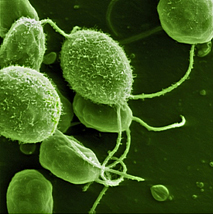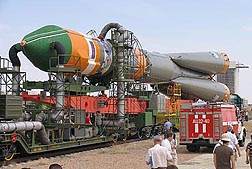This page has been archived and is being provided for reference purposes only. The page is no longer being updated, and therefore, links on the page may be invalid.
| Read the magazine story to find out more. |
 ARS plant physiologist Autar Mattoo and his colleagues recently launched samples of a green algae Chlamydomonas reinhardtii (top) into space on board a Russian-made Soyuz space (bottom) capsule as part of an international effort to study the photosynthetic machinery of crops. Photo courtesy of Dartmouth College |
|
|
Sending Algae into Space to Probe Plants in Extreme Environments
By Dennis O'Brien
May 27, 2014
By sending algae into space, a U.S. Department of Agriculture (USDA) scientist and his cooperators will be able to study some of the key mechanisms that control plant growth and photosynthesis.
The work by plant physiologist Autar Mattoo with USDA's Agricultural Research Service (ARS) is part of an international effort, largely funded by the European Space Agency, to improve the photosynthetic machinery of crops so they produce higher yields and grow in extreme environments. Mattoo works at the ARS Sustainable Agricultural Systems Laboratory in Beltsville, Maryland.
ARS is USDA's principal intramural scientific research agency, and this research supports the USDA priority of promoting international food security.
During photosynthesis, a protein-pigment complex known as Photosystem II (PS II) must constantly be repaired to fix damage caused by sunlight and ultraviolet radiation. As part of that repair process, a protein known as D1 is continuously being replaced. Research has shown that mutations of the D1 protein in the PS II complex can either increase or decrease photosynthetic activity.
The researchers wanted to assess the effects of microgravity, cosmic rays, high-energy particles and the ionizing radiation of space on the PS II complex, photosynthesis and plant growth. They also wanted to see if the effects would differ in a simple model for photosynthesis, an alga, with the D1 gene altered in specific ways.
The researchers placed samples of the alga Chlamydomonas reinhardtii in airtight "photo cells" and had them launched in a Russian-made Soyuz space capsule in Kazakhstan. The C. reinhardtii, often studied as a model for photosynthesis, spent 15 days in orbit getting doses of cosmic radiation while under light and temperature conditions that would ensure growth on earth. They also sent up four mutants of C. reinhardtii with alterations in the D1 protein gene.
They found that some aspect of the space environment inhibited the ability of the control C. reinhardtii and two of the four mutant strains to photosynthesize and grow, both in space and later when they were brought back to Earth. However, two other mutant strains flourished, both in space and when they returned to Earth. The results, published in PLOS ONE, shed new light on the importance of the D1 protein both in photosynthesis and as a target of environmental signals.
Read more about this study in the May/June 2014 issue of Agricultural Research magazine.

